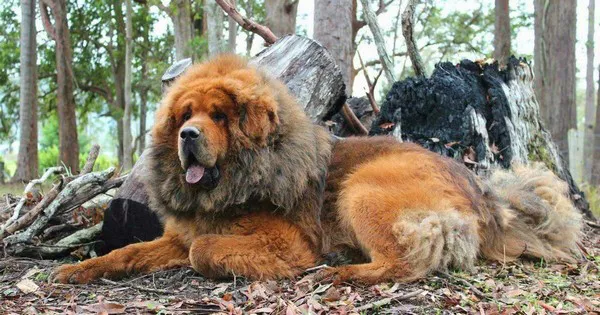Tibetan Mastiffs and wolves are two fascinating creatures, each with its unique characteristics and traits. While both share a genetic connection to the canine family, they are vastly different in various aspects. In this article, we will delve into the distinctions between Tibetan Mastiffs and wolves, shedding light on their physical features, behavior, habitat, and more.
1. Physical Features
Tibetan Mastiff:
Size: Tibetan Mastiffs are large and powerful dogs, with males typically reaching heights of 26 inches or more at the shoulder and weighing between 90 to 150 pounds.
Coat: They boast a thick double coat that comes in various colors, including black, brown, and golden. Their fur is designed to protect them from harsh Himalayan climates.
Tail: They have a bushy tail that curls over their back, adding to their majestic appearance.
Wolf:
Size: Wolves are generally larger than Tibetan Mastiffs. They can stand up to 32 inches tall at the shoulder and weigh between 70 to 180 pounds, depending on the species and region.
Coat: Wolves typically have a thick, grayish-brown or white coat designed for camouflage in their natural habitats. Coat color varies with species.
Tail: Wolves have a straight tail, often held horizontally, which aids in communication within their packs.
2. Behavior
Tibetan Mastiff:
Guardian Instinct: Tibetan Mastiffs are known for their strong protective instincts. They are loyal and make excellent watchdogs, guarding livestock and property.
Gentle Giants: While protective, Tibetan Mastiffs can be affectionate and gentle with their families. Early socialization is key to ensuring they are well-behaved.
Independent: They can be independent thinkers and may not always follow commands blindly.
Wolf:
Pack Animals: Wolves are highly social animals that live in packs. They rely on cooperation and hierarchy within the pack for survival.
Predators: Wolves are carnivorous predators and hunt in packs for prey such as deer, elk, and smaller mammals.
Territorial: Wolves are territorial animals, and their behavior is influenced by the need to protect their territory and resources.
3. Habitat
Tibetan Mastiff:
Domesticated: Tibetan Mastiffs are domesticated dogs that originated in the Himalayan region, where they were bred for guarding and herding purposes.
Diverse Habitats: They adapt well to various climates but are often associated with high-altitude regions due to their Tibetan origins.
Wolf:
Wild Habitat: Wolves are primarily wild animals and can be found in diverse habitats, including forests, tundra, grasslands, and deserts.
Global Range: Wolves have a global presence and are native to North America, Eurasia, and parts of Africa.
4. Diet
Tibetan Mastiff:
Omnivores: Tibetan Mastiffs are omnivorous but primarily eat a diet of high-quality dog food supplemented with meat.
Dietary Variability: Their diet can vary depending on their owner’s choices and dietary needs.
Wolf:
Carnivores: Wolves are obligate carnivores and rely on a diet of animal flesh. Their primary diet consists of large mammals.
Hunting Skills: They are skilled hunters, working together as a pack to take down prey.
Conclusion:
Tibetan Mastiffs and wolves are distinct creatures with unique characteristics, behaviors, and habitats. While Tibetan Mastiffs are domesticated dogs known for their protective nature and loyalty, wolves remain wild, social predators that rely on pack cooperation for survival. Understanding these differences enhances our appreciation for both species and the roles they play in our world.
FAQs related to the topic “Tibetan Mastiff vs. Wolf:
Q1: Are Tibetan Mastiffs related to wolves?
A1: Tibetan Mastiffs and wolves share a common ancestry as both belong to the Canidae family, but they have evolved separately for thousands of years, resulting in distinct species.
Q2: What are the major differences in behavior between Tibetan Mastiffs and wolves?
A2: Tibetan Mastiffs are domesticated, protective, and often independent thinkers. Wolves are wild, social animals that live in packs, hunt cooperatively, and are territorial.
Q3: Can a Tibetan Mastiff be mistaken for a wolf due to its appearance?
A3: While Tibetan Mastiffs have some physical similarities with wolves, such as a thick coat, they can be easily distinguished by their larger size and curled bushy tail.
Q4: Do Tibetan Mastiffs make good pets like dogs, or are they more like wild animals?
A4: Tibetan Mastiffs can make excellent pets when properly socialized and trained. They are known for their loyalty and protective instincts but require early socialization and consistent training.
Q5: Are wolves dangerous to humans?
A5: Wolves generally avoid humans and pose little threat when left undisturbed in the wild. However, like any wild animal, they can be unpredictable and may become defensive if cornered or threatened.
Q6: What are some conservation efforts to protect wolves in the wild?
A6: Various organizations and governments work to protect and conserve wolf populations. This includes habitat preservation, research, and managing human-wolf conflicts to promote coexistence.
Q7: Are there any laws against owning a Tibetan Mastiff or keeping a wolf as a pet?
A7: Laws regarding the ownership of Tibetan Mastiffs vary by location and may involve breed-specific regulations. Keeping a wolf as a pet is generally illegal or highly regulated due to their wild nature.
Q8: Do Tibetan Mastiffs have any special dietary requirements compared to domesticated dogs?
A8: Tibetan Mastiffs primarily require a high-quality dog food diet with meat as a primary component. Their dietary needs are similar to those of other large breed dogs.
Q9: Are there any conservation concerns related to Tibetan Mastiffs?
A9: Tibetan Mastiffs are not a conservation concern, as they are a domesticated breed. However, preserving their genetic diversity is important to maintain breed health.
Q10: Can Tibetan Mastiffs and wolves interbreed?
A10: No, Tibetan Mastiffs and wolves cannot interbreed. They are separate species with different numbers of chromosomes, making crossbreeding biologically impossible.


